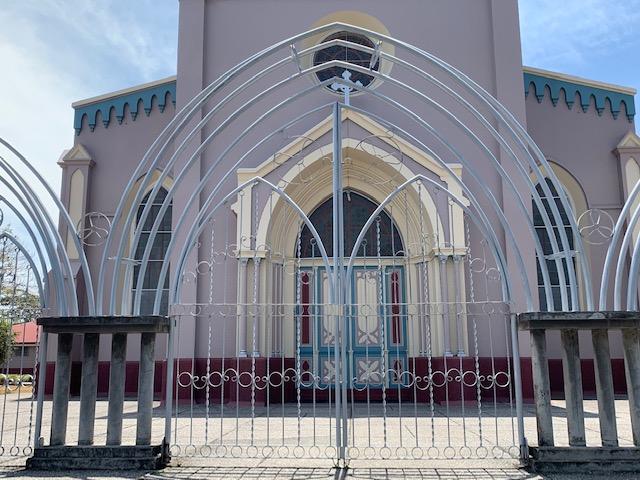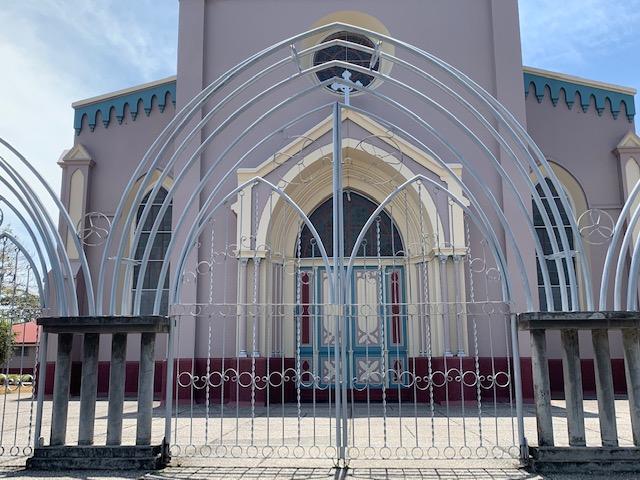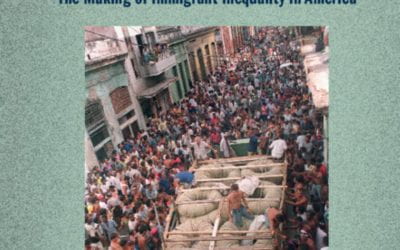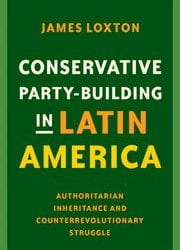Letter from Costa Rica
The Strategy of Isolation with Solidarity
In my home office, the engraving “El solitario”—“The Solitary One”— by famed Costa Rican artist Francisco Amighetti has accompanied me for many years. The image is divided into two planes. At the bottom, a quite lively group is festively socializing with glasses of wine and rum in hand. At the top, a listless figure, caught up in his own loneliness, looks out at a balcony practically suspended in the sky.

I used to identify with the solitary figure intimately; all of us, at one moment or other, need to take refuge within ourselves. But Covid-19 has made me appreciate the engraving in another dimension: that of an imposed isolation as a necessity of collective protection; the renunciation of personal interaction as an imperative safeguard for health, the return to our inner selves that has been activated as an inevitable daily obligation.
It is no longer an individual option, but a call for human survival; both solitude and distance become strategies of solidarity.
As in so many other countries, to isolate and distance ourselves have been a key part of facing the pandemic in Costa Rica. Unil now, although uncertainty reigns and the economic effects of the crisis portend to be devastating, the results in terms of health and mortality are cause for hope.
At midday on April 19, there were 660 confirmed cases of covid-19 in 59 of the country’s 82 municipalities; 7,142 potential cases eliminated as a result of testing, 112people recovered, 15 hospitalized (10in intensive care) and four dead (Costa Rica has slightly more than five million inhabitants.) Thanks to a reduction in daily cases since the April 9th, the epidemiological curve is moderate, and the saturation of health services has been avoided.
The preventive restrictions have not been imposed with an air of arbitrary authoritarianism, as in some other countries such as, at distant extremes, China and El Salvador. Instead, the government has applied incremental measures as the pandemic evolves. These measures have been based, essentially, on the General Laws of Health and of Transportation. The first gives the authorities the power to make a wide range of decisions in the face of health emergencies, including closing establishments; the second permits restrictions on the circulation of vehicles.
These capabilities, together with an intensive public relations campaign in favor of physical distancing, have permitted individual rights to continue in effect, without direct limitations.
Since March 6, when the first case (that of a U.S. tourist) was confirmed, that authorities have opted for a gradual strategy. As a matter of fact, the strategy had begun a few days before the first case was confirmed, insisting that people was their hands; not kiss, hug or give handshakes in greetings; giving instructions on how to cover coughs; activating early warning protocols, and providing for the import of necessary supplies for coronavirus test kits, tests which inititially could only be performed in a state laboratory, but now have extended to some private ones).
On March 9, the government launched the campaign #quedateEnCasa (#Stay at Home). It also banned gatherings of crowds and encouraged working from home. On the 12th, school was suspended—from kindergarten to university—and no reopening date has been scheduled. Three days later, the government ordered all discotheques, bars and casinos closed, and greatly restricted the seating capacity of restaurants. Later, all religious denominations complied with the government request to suspend in-person religious services.

With the declaration of a national emergency on the 16th, non-resident foreigners could not enter the country, and foreigners who left the country without a justified reason after that date would lose their migratory status.
Two days after the death of an esteemed 87-year-old pediatrician, on March 18th, the first death attributed to the virus, two other senior citizens and a 45-year-old man have died.
The next step was to close down the access to beaches and national parks, followed by a curfew that prohibited the circulation of private cars (with a few specific exceptions) between 10 p.m. and 5 a.m. During Holy Week from April 6-12—a traditional vacation period—the curfew was imposed all day long, but the Monday after, the curfew was imposed from 7 p.m. to 5 a.m.
On March 31, after a marathon two-week conversion, a rehabilitation hospital began to operate exclusively as one exclusively for coronavirus patients to reduce the pressure on the rest of the system and the possibility of contagion in other hospitals.
A nationwide universal system of health care with different degrees of oversight and attention has been the fundamental bedrock of the strategy. Its organization, taking into account differences in resources, is similar to that of the National Health Service (NHS) in the United Kingdom, and the Costa Rican Social Security Institute (la Caja Costarricense de Seguro Social), which collects benefits and directly provides services, is generally as well-regarded by the public as the NHS.
From the very beginning, the Institue has been the mainstay for the detection of suspicious cases and administered the appropriate tests. This has permitted it, at least up until now, to maintain control and have ability to do contact tracing that minimizes the need for a massive use of the tests, difficult to afford.
The most recent step in the chain of preventive actions has been the use of a voluntary digital app in which each person transmits his or her symptoms, receives a risk classification and keeps up to date any perceived changes.
At the same time, a group of measures aim to improve hospital supplies, elaborate contingency plans and redistribute equipment.
The greatest Achilles’ heel of this strategy revolves around those who live in marginal neighborhoods, as well as the homeless and prison inmates. In spite of the existing socio-economic, educational and health support network that attends this marginal population, physical distancing is almost impossible because of overcrowding in cramped spaces; among the homeless who live on the streets and prison populations who are confined to shared pavilions, the situation is even worse.
Another great concern for Costa Rica is the contempt with which the government of Daniel Ortega has faced the epidemic in the neighboring country of Nicaragua. The possibility of a runaway contagion in Nicaragua, aggravated by its collapsed health system, could increase migratory pressures and challenge the capacities of Costa Rica. Although strict border controls exist between the two countries, there has always been a flow of migrants without documents who elude official crossing points.
The epidemiological dynamics can be contained, but not controlled, above all, if the approach depends on others. At any moment, the impact could multiply and overwhelm the capacity to confront the pandemic. For now, even though this has not been the case, the risk is still there. And to this risk is added a second challenge: a rapid and alarming economic deterioration.
When the emergency arose, the Costa Rican economy had only barely started to give signs of reactivation, after almost a year of slowing down, The fiscal crisis, manifested in a deficit close to 6% of Gross National Product (GNP) and an accumulated debt equivalent to a little more than 57% of the GNP, was slowly being controlled, thanks to a reform approved last December.
Only the financial system was very solid, with robust liquidity, solvency and money reserves in the Central Bank, in addition to an accumulated inflation the previous year of less than 2%.
With the Covid-19 crisis, the international export of products and services swiftly contracted, although some export sectors such as manufacturers of medical supplies or microprocessors have maintained flourishing activity, they are the exception, rather then the rule. Tourism, Costa Rica’s main source of foreign exchange and a great generator of employment, has plummeted. Local trade is experiencing its worst crisis in decades, and several domestic manufacturers, as well as agriculture exporters, have suffered huge blows. As a consequence, and although no official statistics are yet available, unemployment has increased dramatically.
To deal with a shock of such magnitude from the vantage point of economic weakness is particulary difficult. It demands a financial, technical and legal instrument difficult to formulate and also limited in scope. Moreover, in contrast with the consensus over issues of public health, the debate over the correct mix of compensatory measures or consumer stimulus is marked by differences in political ideologies.
In spite of this, the politically weak executive power and the Congress, the most fragmented in the modern history of Costa Rica, have managed to draw up a series of agreements with unusual speed and without many hitches.

Essentially the focus has been on reallocating budget funds from their original destinations to the health and economic emergency. The measures have also called for a “solidarity tax” on the highest salaries. They seek to make the standards for layoffs or reductions in labor contracts more flexible and to permit a proportional withdrawal of unemployment insurance for those receiving a lower percentage of their income. Another issue agreed upon was to quickly seek approval with international financial institutions to partially divert funds to deal with the effects of the pandemic.
These decisions, in addition to providing relief to the productive sector, are also directed at granting direct subsidies to the unemployed, to strengthen the network that already attends disadvantaged families and to stimulate overall consumer spending.
The regulatory authorities of the financial system, for their part, have loosened the requirements on reserve levels to maintain their operations for the commercial banks (the two largest belong to the state) and have created conditions so that possible payment arrangements with debtors do not have repercussions for their balances. The Central Bank has lowered the El Banco Central has lowered the benchmark interest rate and obtained congressional authorization to acquire, if necessary, government-issued debt.
The horizon established for this package of measures is three months. Much is still not known: Will these measures be sufficient to prevent a possible economic collapse (a recession is something else); how will the public coffers resist, already decimated by the fiscal crisis and increased spending; what will be the future cost for the overall economy and the taxpayers, and how profound will the impact be on Costa Rica’s credit in the international markets.
In the midst of some dissident voices, up until now, a consensus exists that in the face of health and economic challenges, the balance of public policy has been adequate. Given the relative success in the pillar of health, one of the great tasks for the authorities in the coming days will be to maintain the social discipline to avoid accelerating the spread of the virus and not to act hastily and prematurely in lifting the restrictive measures, while, at the same time carefully and gradually advancing toward the difficult return to normality.
The principal bet is still on distancing. The listless figure of “El solitario” becomes a symbol, at least for me. Many lives depend on keeping apart. But we ought to complement that distance with the closeness of collective solidarity. Together, we seek to be able to leave our balconies—real or virtual—and to join, fully, the society of which we are a part.
Carta de Costa Rica
La estrategia de aislamiento solidario
Por Eduardo Ulibarri
Desde hace muchos años, en mi estudio me acompaña “El solitario”, grabado de Francisco Amighetti, figura clave del arte costarricense. La imagen se divide en dos planos. En el inferior, un animado grupo interactúa festivamente, copas y vasos en mano. En el superior, una figura lánguida, ensimismada en su soledad, se asoma a un balcón casi suspendido en el cielo.

Antes me identificaba con el personaje desde una perspectiva íntima: todos, en algún momento, necesitamos refugiarnos en nosotros mismos. Pero el covid-19 me ha hecho apreciarlo en otra dimensión: la del aislamiento impuesto como necesidad de protección colectiva; la renuncia a la interacción personal como imperativo sanitario, la vuelta a nosotros mismos que se activa como inevitable obligación cotidiana.
Ya no es una opción individual, sino un llamado a la supervivencia humana; la soledad y la distancia como estrategias de solidaridad.
Como en tantos otros países, aislarnos y distanciarnos han sido en Costa Rica elementos centrales del guión ante la pandemia. Hasta ahora, aunque la incertidumbre abunda y los efectos económicos se asoman demoledores, los resultados, en el ámbito de la salud y la vida, generan esperanzas.
Al 19 de abril a mediodía, había 660 casos confirmados del covid-19 en 59 de los 82 municipios del país, 7.142 descartados mediante pruebas, 112 recuperados, 15 hospitalizados (10 en cuidados intensivos) y cuatro muertos (Costa Rica tiene poco más de cinco millones de habitantes). Gracias a una reducción en casos nuevos, la curva epidemiológica es moderada y ha evitado saturar los servicios de salud.
Las restricciones preventivas no se han manifestado con sabor de arbitrariedad autoritaria, tal como ha sucedido en otros países, como –en extremos distantes—China y El Salvador. En su lugar, se han aplicado acciones paulatinas ante la evolución de la epidemia. Se han sustentado, esencialmente, en las leyes General de Salud y de Tránsito. La primera otorga a las autoridades un amplio ámbito de decisiones frente a amenazas sanitarias, incluido el cierre de establecimientos; la segunda permite restricciones a la circulación de vehículos.
Estas competencias, más una intensa campaña en pro del distanciamiento físico, han permitido mantener en vigencia los derechos individuales, sin limitar su ejercicio en forma directa.
Desde que se confirmó el primer caso (una turista estadounidense), el 6 de marzo, las autoridades optaron por una estrategia progresiva. De hecho, había comenzado días antes, con la insistencia en el lavado regular de manos, la contención en los saludos personales, cubrirse la boca al toser, la activación de protocolos de alerta, y la importación de los insumos necesarios para las pruebas de contagio, que primero solo podía hacerlas un laboratorio estatal y ahora se han extendido a algnos privados.
El 9 se lanzó la campaña #quedateEnCasa, se impidieron las actividades masivas y comenzó a estimularse el teletrabajo. El 12 fueron suspendidas las clases, desde preescolar hasta la universidad; aún no hay fecha para su reinicio. Tres días después vino el cierre de discotecas, bares y casinos, y restricciones al aforo de los restaurantes. Luego, todas las denominaciones religiosas acataron la solicitud gubernamental y suspendieron sus oficios presenciales.
Con una declaratoria de emergencia nacional, el 16, se suspendió el ingreso de extranjeros sin residencia, y se decretó que quienes salieran del país a partir de esa fecha, sin razón justificada, perderían su condición migratoria.

A la muerte de un connotado pediatra de 87 años, el 18 de marzo, la primera causada por el virus, siguieron las de otros dos adultoa mayores y un hombre de 45.
La orden de cerrar el acceso a las playas y parques nacionales se añadió al repertorio de medidas, junto a la prohibición a la circulación de vehículos particulares (salvo excepciones calificadas) entre 10 p.m. y 5 a.m. Las restricciones se hicieron también diurnas durante Semana Santa (una tradicional época de vacaciones), entre el 6 y el 12 de abril; a partir del día siguiente, se aplican entre las 7 p.m. y las 5 a.m.
El 31 de marzo, tras una maratónica reconversión durante dos semanas, un hospital especializado en rehabilitación comenzó a funcionar, exclusivamente, para enfermos del coronavirus, con el propósito de reducir la presión sobre el resto del sistema y las posibilidades de contagio en los otros hospitales.
Contar con un sistema universal de salud, presente, con distintos niveles de vigilancia y atención, en todo el territorio, ha sido un bastión fundamental de la estrategia. Su organización, guardando las distancias en recursos, es similar a la del National Health Service, del Reino Unido, y la entidad a cargo, la Caja Costarricense de Seguro Social (recaudadora y proveedora directa de servicios), tan reverenciada por la población como el NHS.
Desde su primera línea de servicios, ha sido el eje para la detección de casos sospechos, a los que se les administran las respectivas pruebas. Esto ha permitido, al menos hasta ahora, un control y trazabilidad de los contagios sin necesidad de tests masivos, difíciles de costear.
El paso más reciente en la cadena de acciones preventivas ha sido una aplicación digital voluntaria, en la que cada persona revela sus síntomas, recibe una clasificación de riesgo y actualiza los cambios que detecte.
A la vez, se ha venido aplicando un conjunto de medidas para mejorar la dotación en los hospitales, elaborar planes de contigencia y redistribuir equipos.
Los grandes talones de Aquiles de esta estrategia son los barrios en precario, la población indigente y los reclusos. Pese a la red de apoyo socioeconómico, educativo y sanitario que atiende a la población marginal, para ella el distanciamiento físico es virtualmente imposible, por su hacinamiento en espacios muy pequeños; entre los indigentes que viven en las calles y los reos que conviven en pabellones comunes, la situación es peor.
Otra gran preocupación es el desdén con que el gobierno de Daniel Ortega ha enfrentado la epidemia, y la posibilidad de que un contagio exponencial en Nicaragua, país vecino, agravado por su sistema de salud colapsado, incremente las presiones migratorias y acreciente los desafíos a las capacidades de Costa Rica. Aunque los controles en la frontera entre ambos países son muy rigurosos, siempre ha existido una gran afluencia de migrantes nicaragüenses no documentados.
Las dinámicas epidemiológicas pueden administrarse, pero no controlarse, sobre todo si, en parte, su abordaje también depende de otros. En cualquier momento su impacto puede multiplicarse y desbordar la capacidad de enfrentarlo. Por ahora, este no ha sido el caso, pero el riesgo se mantiene. A esto se añade el segundo gran desafío: un rápido y alarmante deterioro económico.
Al momento de desatarse la emergencia, la economía costarricense apenas comenzaba a dar señales de reactivación, tras casi un año de desaceleración. La crisis fiscal, manifiesta en un déficit cercano al 7% del producto interno bruto, y una deuda acumulada equivalente a poco más del 57%, estaba en vías de ser contenida lentamente, gracias a una reforma aprobada en diciembre del pasado año.
Solo el sistema financiero disfrutaba de gran solidez, con robusta liquidez, solvencia y reservas monetarias en el Banco Central, además de una inflación acumulada en el año inferior al 2%.
Con el golpe, las ventas de productos y servicios al exterior se han contraído aceleradamente; aunque algunos sectores exportadores, en particular los que producen dispositivos médicos o microprocesadores, han logrado mantener una saludable actividad, ellos son parte de la excepción, no la regla. El turismo, mayor fuente de divisas y gran generador de empleo, se ha desplomado. El comercio local vive su peor crisis en décadas, y varias empresas manufactureras de base nacional, lo mismo que los exportadores agrícolas, han sufrido golpes de gran magnitud. Como consecuencia, y aunque no existan todavía cifras oficiales, el desempleo ha crecido dramáticamente.
Hacer frente a un shock de tal magnitud desde una posición de debilidad económica, es particularmente difícil. Requiere un instrumental financiero, técnico y legislativo difícil de articular, y también escao. Además, la polémica sobre la mezcla adecuada de medidas compensatorias, o de estímulos al consumo, está marcada, al contrario de la salud, por diferencias políticas ideológicas.
A pesar de todo esto, el Poder Ejecutivo, débil políticamente, y la Asamblea Legislativa, la más fragmentada en la historia moderna de Costa Rica, han logrado articular una serie de acuerdos con inusitada fluidez y rapidez.
Esencialmente, se han enfocado en reorientar recursos presupuestarios desde sus destinos previos hacia la emergencia, impulsar un “impuesto solidario” a los salarios más altos, permitir moratorias temporales de ciertos tributos, flexibilizar la legislación para autorizar el cese temporal o la reducción de contratos laborales, permitir el retiro proporcional de un modesto seguro de desempleo a quienes reciban porcentajes menores de sus salarios, y aprobar con celeridad créditos con organismos financieros internacionales, que también serán reorientados parcialmente a atender los efectos de la epidemia.
Estas decisiones, además de brindar alivio al sector productivo, van orientadas a otorgar subsidios directos a los desempleados, reforzar la red que ya atiende a familias en estado de marginación, y estimular el consumo agregado.

Las autoridades reguladoras del sistema financiero, por su parte, han flexibilizado el nivel de reservas exigido a los bancos para atender sus operaciones, y han creado condiciones para que posibles arreglos de pago con deudores no repercutan en sus balances. El Banco Central ha bajado la tasa de interés de referencia y obtuvo autorización legislativa para adquirir, de ser necesario, deuda emitida por el gobierno.
El horizonte establecido para este conjunto de medidas es de tres meses. A su alrededor existen, al menos, cuatro grandes incógnitas: si serán suficientes para evitar un posible desplome económico (la recesión está descontada); cuánto resitirán las arcas públicas, diezmadas por la crisis fiscal, el incremento en los gastos; cuál será el costo a futuro para el conjunto de la economía y los contribuyentes, y cuán profundo el impacto sobre la capacidad crediticia de Costa Rica en los mercados internacionales.
En medio de voces disidentes, hasta ahora existe el consenso de que, frente al desafío sanitario y económico, los balances de política pública han sido adecuados. Dado el relativo éxito en el pilar de la salud, una de las grandes tareas para las autoridades en los próximos días será mantener la disciplina social que evite acelerar el contagio, y no precipitarse en eliminar prematuramente las medidas restrictivas, mientras, a la vez, se avanza en una cuidadosa, paulatina y difícil vuelta a la normalidad.
La apuesta principal aún es al distanciamiento: la lánguida figura de “El solitario” como símbolo, al menos mío. De ella dependen muchas vidas. Pero debemos complementarla con una cercana solidaridad colectiva y la meta de que, tan pronto como sea posible, podamos dejar nuestros balcones –reales o virtuales– y sumarnos, plenamente, a la sociedad de la que somos parte.
Related Articles
A Review of Cuban Privilege: the Making of Immigrant Inequality in America by Susan Eckstein
If anyone had any doubts that Cubans were treated exceptionally well by the United States immigration and welfare authorities, relative to other immigrant groups and even relative to …
A Review of Conservative Party-Building in Latin America: Authoritarian Inheritance and Counterrevolutionary Struggle
James Loxton’s Conservative Party-Building in Latin America: Authoritarian Inheritance and Counterrevolutionary Struggle makes very important, original contributions to the study of…
Endnote – Eyes on COVID-19
Endnote A Continuing SagaIt’s not over yet. Covid (we’ll drop the -19 going forward) is still causing deaths and serious illness in Latin America and the Caribbean, as elsewhere. One out of every four Covid deaths in the world has taken place in Latin America,...



